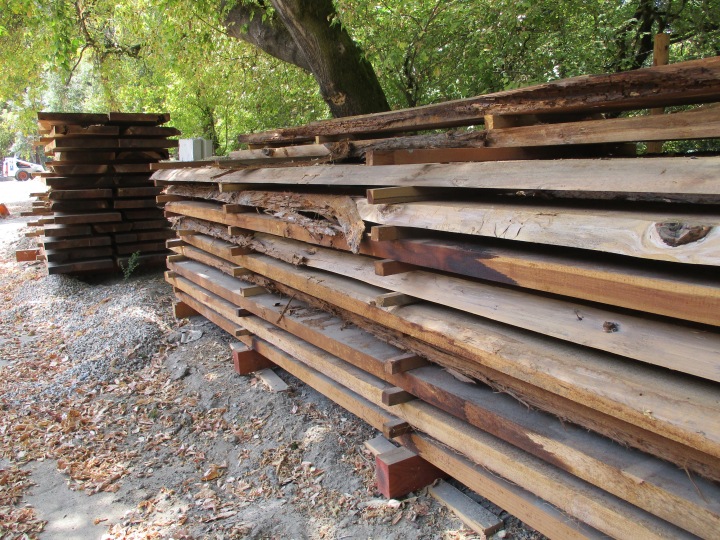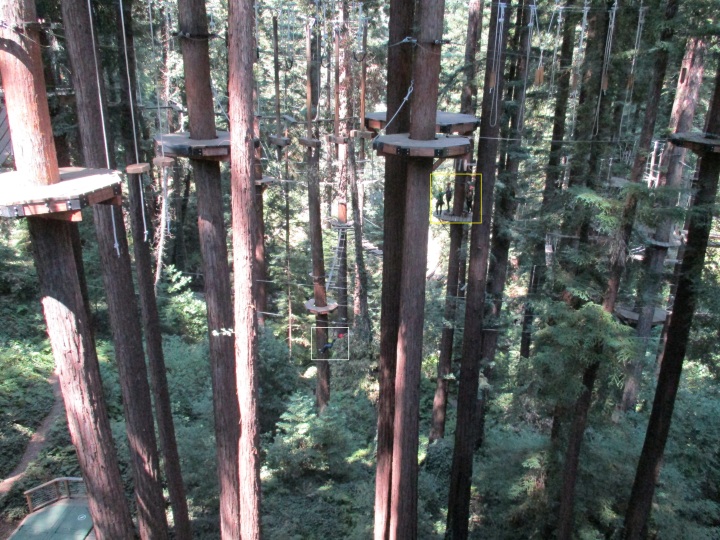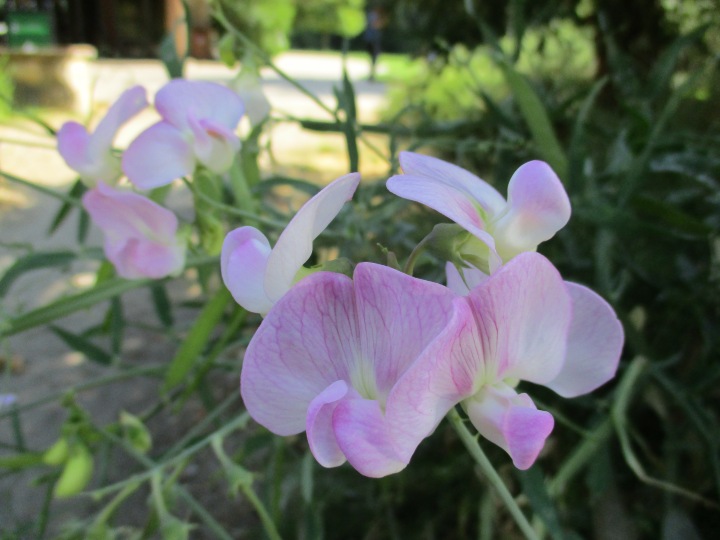Redwoods are such interesting trees. There is always something to write about them. I happen to live and work within the native range of the coastal redwood. I often work with very big redwoods, both in the wild, and in landscaped areas that were formerly wild. There are no other trees that are comparable. The giant redwoods in the Sierra Nevada are bigger, but they are also very different.
1. In most home gardens and landscapes, trees that get cut down get recycled into greenwaste and firewood. Not many are big enough to get recycled into lumber. Even fewer are big enough to get milled into big timbers. This milled redwood lumber is drying before getting milled again into timbers and smaller sizes of lumber that will get used to repair and remodel some of the historical old buildings. A bit of pine lumber is also obtained from the big ponderosa pines nearby.
2. Limbs, foliage, bark and parts of the redwood trees that can not be milled into lumber get chipped. Chips get used as mulch in landscaped areas. After taking this picture, I realized that it is not really a pile of chipped redwood, but is instead chipped wood waste. Chipped redwood is typically green with foliage. Oh well, you get the idea.
3. The Ewok Village of ‘Star Wars IV – Return of the Jedi’ was in a redwood forest near Fortuna. This is not really an Ewok Village.
4. It is a Redwood Canopy Tour. People (not Ewoks) can be seen on a platform in the yellow rectangle just above and to the right of the center of the picture. Someone on a zip line can be seen in the white rectangle just below and barely to the left of the center. It looks crazy to me, but many of my colleagues do crazier things at work.
5. Most of us have seen pictures of massive redwood trunks. Most of us have seen pictures of redwood forests. Not so many of us have seen what the foliage looks like.
6. This perennial pea has nothing to do with redwoods, but needed to be included as a token flower for this week. Besides it is cool. It is softer pink than the bright purplish pink that is so typical, and is blooming very late.
This is the link for Six on Saturday, for anyone else who would like to participate:
https://thepropagatorblog.wordpress.com/2017/09/18/six-on-saturday-a-participant-guide/
Here are a few links for some of my brief articles about redwood:
https://tonytomeo.com/2018/08/17/dawn-redwood/
https://tonytomeo.com/2018/08/12/general-sherman-tree/
https://tonytomeo.com/2018/08/04/albino/
https://tonytomeo.com/2018/08/04/six-on-saturday-bits-and-pieces-ii/
https://tonytomeo.com/2018/07/14/six-on-saturday-redwoods/
https://tonytomeo.com/2018/05/12/six-on-saturday-tree-ring-circus/
https://tonytomeo.com/2017/10/15/redwoods/
https://tonytomeo.com/2017/10/05/big-tree-in-a-small-town/
Thank you for highlighting the redwoods are magestic trees. I love them ! (Hmm … all this mulch would be nice in my borders …)
LikeLiked by 2 people
I should have mentioned that redwood mulch has an herbicidal effect. It is great for keeping weeds down, but is not so good around young plants.
LikeLiked by 1 person
Nice lumber. I have often fantasised about being a lumberjack. Read a great short story by Wallace Stegner called Saw Gang this Summer which fuelled my fantasy! Check it.
LikeLiked by 3 people
. . . that is a weird fantasy. The towns of the San Lorenzo Valley are old lumber towns, which are completely different from the agricultural (orchard) towns of the Santa Clara Valley just a few miles away. Those of the Valley did not speak to well of those in the Mountains. But hey, they got to work with some of the most excellent trees in the World!
LikeLike
MASSIVE respect for mention of Wallace Stegner, one of my favourite authors and almost unknown this side of the pond.
LikeLiked by 1 person
That’s amazing, to see the people in the picture accentuating the enormous size of the trees. Lucky you highlighted them otherwise I mightn’t have noticed them.
LikeLiked by 2 people
I actually did not know I got the person on the zip line until looked very closely at the picture. I remember taking the picture while someone was whizzing by, but was not sure I got it in the picture.
This is a touristy region, and old pictures of the original redwoods are a common motif in touristy restaurants, bars and such. There are many pictures of crews of those harvesting the timber posing within the felling cuts of the big trees.
LikeLiked by 1 person
Very interesting, Tony. I hadn’t thought about what happens to not-live redwoods. Also didn’t know folk used them in recreation. And then, going from the woodland giants to a garden pea . . . too funny.
LikeLiked by 1 person
Each tree makes a lot of lumber. It would be irresponsible to waste too much of it. The forests here are a bit too crowded with secondary redwood growth anyway, that a bit of selective harvesting would be healthy for the collective forest.
LikeLiked by 1 person
would love to do the canopy tour some day!
LikeLiked by 1 person
My colleagues who work in big trees love what they do. I just want to grow the baby trees . . . and stay on the ground where I belong. To do that sort of thing recreationaly just seems odd.
LikeLiked by 1 person
Yikes! Got to be dangerous to take one down!
LikeLiked by 1 person
We do not often take one down. Gravity and wind do that for us. Actually, each tree lives for many centuries, so it is extremely rare that one falls. In my entire career, I have inspected only two redwoods that have fallen, and both were in landscape trees (that were planted rather than wild). They are remarkably stable. Really, the trees that needed to be removed were destabilized and would have eventually been in danger of falling. Yes, it is rare, but we wanted to get to it before they did. They were so tall that, if they had fallen, they could have destroyed Reno . . . and Utah. If you ever need redwood lumber, we might be able to aim one in your direction as we cut it down.
LikeLiked by 1 person
I love that you put in a token flower! Are you sure there are no ewoks?
LikeLiked by 1 person
I am certainly not sure about the Ewoks, but I have never seen them here. You know, the native people who lived in the region centuries ago happened to be the Miwok. I doubt they were related. Supposedly, Sasquatch lived at at my former home. Investigators for one of those silly reality shows wanted to come over to hunt for it.
LikeLiked by 1 person
🙂 I do love the stories.
LikeLiked by 1 person
I’m from Eureka. When I was a child we played in a redwood forest behind our house. The enormous stumps provided wonderful forts. I’ll never forget the soft moist feel of the earth, the fallen logs, the moss….the enormous banana slugs… Now they are all gone. They literally cut down the trees and put up a parking lot. It pains me to think of 1,000 year old trees being chipped for mulch.
LikeLiked by 1 person
At my former home, my outhouse was built on top of a hollow rotting stump, and my shower was built inside of another burned out stump. We love our redwoods here. Even though I know that selective harvesting of the crowded secondary growth benefits the collective forest. I do not want to lose any of the trunks any time soon. Most of mine are only about a century old. They grew up since the area was harvested after the Great Earthquake. I will let the next generation worry about harvesting them, when I am not around to watch.
LikeLike
I’m with you! Long may they stand sentinel.
LikeLiked by 1 person
#5 is a great shot, nicely demonstrating the contrast between the giant redwood trees and their foliage!
LikeLiked by 1 person
Thank you. The foliage is surprisingly delicate for such a bold tree.
LikeLike
Wow! Huge trees aren’t they….still want to see them! One day……
Interesting post Tony. Thank you for sharing.
LikeLiked by 1 person
You are welcome. I so enjoy showing off the trees that I get to work with, even if I do not actually do anything with them.
LikeLiked by 1 person
Thanks for this post Tony. I do love the Redwood, both the Coastal and the General Sherman kind. Not so keen on the Ewok village. Nothing against Ewoks, fine folk I’m sure, though like yourself, I have no personal experience with them, however, I’m not so keen on doing that sort of thing with trees. It may not harm them much perhaps but it cannot do them any good either.
I wonder that the foliage must need be delicate because of potential occasional snow accumulation and too when at great heights it would be less bothered by wind. Great write up and photos. thanks again. Can’t wait for your next piece on Redwoods!
LikeLiked by 1 person
Several people in the neighborhood object to humiliating the trees in this manner. I try to mind my own business, but I sort of agree. I do not like seeing all that infrastructure up in the trees. It is worse that those who enjoy the tour do it merely for the adrenaline rush, but have no appreciation for the trees that provide it. They could just as easily ride roller coasters at the Boardwalk in Santa Cruz! Coastal redwoods do not like snow at all. Snow is extremely rare here. When it happens in the upper elevations every decade or so, it breaks limbs. Redwoods can not support the extra weight. Those who are near the coast might tolerate the weight of snow better, but never experience it.
LikeLike
Can you build with redwood? Have just spent a couple of weeks in cabins built from Scots pine and wonder if you can make something similar with redwood?
LikeLiked by 1 person
Redwood is used near the ground. For example, it is used for the pilings under homes, and the main beams that go onto the pilings. It is remarkably resistant to decay and termites. However, it is not used much above that anymore. It is more brittle than fir. Besides, there are not enough trees to provide lumber for everything. Fir regenerates faster, and is better for structural applications, so is the common wood for construction.
This region was harvested very extensively for redwood after 1906 to rebuild San Francisco and the rest of the Bay Area after the Great Earthquake and Fire. Entire homes and buildings were built with it back then just because it was available and close to where it was being used. The Winchester House in San Jose is built out of redwood. Harvesting is very limited now, and only done from large parcels.
LikeLiked by 1 person
In So Cal, many of the back-yard decks are made of redwood still. It lasts pretty well, and maintains its beauty!
LikeLiked by 1 person
Fences are made of redwood as well. Here within the native range, the old stumps are sometimes milled as virgin growth redwood. I would not mind stumps being harvested, but in may garden, even the stumps are rad.
LikeLiked by 1 person
Thanks for the info!
LikeLiked by 1 person
What magnificent trees I’m pleased you marked the people, even then I had to enlarge the picture to see them. Gave a real perspective to the size of the trees
LikeLiked by 1 person
I wanted to make the rectangles bolder, but could not figure out how to do it.
LikeLiked by 1 person
I must admit I had to search for it
LikeLiked by 1 person
oops.
LikeLiked by 1 person
I have a “dwarf” form of coast redwood in my garden, under the name ‘Adpressa Nana’, which doesn’t seem to be a valid name. I think it would make a big tree but I chop it back, being one of the few conifers you can, to keep it below 3′. The tallest UK ‘Adpressa’ is 26m and the tallest of the species is 57m. (187ft) planted 1845, at Longleat. In general it grows less well here than Giant Redwood.
LikeLiked by 1 person
That is a cultivar that I am not familiar with, if it is valid. There is an ‘Adpressa’ and a ‘Nana Pendula’. Of course, there are many cultivars that I have never heard of. The cultivars are more popular elsewhere than they are here. Almost all of our nursery grown trees (in landscapes) are ‘Soquel’. Some are ‘Aptos Blue’. Very few are ‘Santa Cruz’ and even fewer are the bluish and pendulous ‘Woodside’. I would guess that coastal redwood would do well there, but it may be too cool for too long in winter.
LikeLike